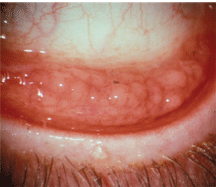 Discussing chlamydia, a sexually transmitted urogenital disease, with a patient is a sensitive subject, which may be one reason it is often underdiagnosed. Given the potentially serious sequelae that may result, however, a proper diagnosis is absolutely critical. In women, chlamydia can cause infection and scarring of the uterus, fallopian tubes and ovaries. In men, the disease can cause epididymitis.
Discussing chlamydia, a sexually transmitted urogenital disease, with a patient is a sensitive subject, which may be one reason it is often underdiagnosed. Given the potentially serious sequelae that may result, however, a proper diagnosis is absolutely critical. In women, chlamydia can cause infection and scarring of the uterus, fallopian tubes and ovaries. In men, the disease can cause epididymitis.
Adult inclusion conjunctivitis (AIC) is an underdiagnosed ocular manifestation of Chlamydia trachomatis, a sexually-transmitted bacteria. AIC is one of the most common causes of persistent conjunctivitis observed in clinical practice. Some 54% of male patients and 74% of female patients who have AIC have concomitant urogenital chlamydial infections.1 Chlamydia is the leading cause of preventable blindness in the world, and its D-K serotypes are responsible for most cases of AIC in developed countries.2,3 This months column discusses the presentation, diagnosis and treatment of AIC.
Presentation
Chlamydia is the most common sexually transmitted disease in the United States; the Centers for Disease Control and Prevention (CDC) estimates that nearly 3 million Americans are affected by the disease each year.4 It is caused by Chlamydia trachomatis, a gram-negative intracellular microorganism, and it is often referred to as a silent epidemic because it produces few or no symptoms and may remain latent for months or even years.
Follicular palpebral conjunctivitis in a patient with adult inclusion conjunctivitis from chlamydia.
AIC typically affects sexually active men and women between the ages of 16 and 34; however, the disease may also affect neonates and elderly individuals.5 It initially presents unilaterally but often progresses to a bilateral condition.6 The key finding is a follicular conjunctivitis, most notably in the inferior palpebral conjunctiva.7 Other findings include peripheral corneal infiltrates and corneal neovascularization, or micropannus.8 For this reason, especially in contact lens-wearing patients, the disease is frequently misdiagnosed as a contact lens-related peripheral infiltrate.

Although we may not consider the presence of sub-epithelial peripheral infiltrates when diagnosing AIC, they are a likely finding, given the immunological response.9 Another finding: either ipsilateral preauricular or cervical lymphadenopathy, which appear as hard, non-tender lymph nodes.10,11 The patient and his or her partner often have a concurrent urinary tract infection as well.
Diagnosis
The diagnosis is typically made through clinical monitoring, especially observation of the follicular lower palpebral conjunctiva. A recent urinary tract infection may serve as an additional clue in your diagnosis.
If you suspect AIC, you can obtain conjunctival scrapings, but these often show low yield of infectious elementary bodies.12 Therefore, the majority of chronic follicular conjunctivitis cases are diagnosed based on clinical observation and history.
Treatment
Because it is a systemic condition, treat patients whom you suspect have AIC with 100mg oral doxycycline b.i.d. Continue treatment until the follicles resolve, which may take several weeks.
A single, 1g dose of azithromycin is an equally effective treatment, and might be indicated in many circumstancesas in, pregnancy, in which doxycycline, the preferred drug, has been found to affect the infants skeletal and dental development.13
A study on 120 male patients was randomized between a treatment of 1g of azithromycin or 100mg of doxycycline b.i.d. for seven days. The eradication rate was 96% for azithromycin and 100% for doxycycline, but there was no statistical
difference in efficacy between the treatment methodologies.14
Remember that the individuals partner requires treatment as well. If the partner is a sexually-active female of childbearing age, consider using azithromycin as a treatment option because it has less potential for causing teratogenicity or interfering with the effectiveness of birth control pills than many broad-spectrum antibiotics.
Another study looked at the use of a three-day Zithromax Z-Pak (azithromycin, Pfizer) and found it to be just as or even more effective than 1g of azithromycin or doxycycline for seven to 14 days.15 Oral medications, such as azithromycin, will eliminate Chlamydia trachomatis without need for additional topical therapy.
Given the potentially devastating systemic and ocular complications of chlamydia, all patients who have AIC, as well as their sexual partners, should be examined and treated systemically. If left untreated, sterility/infertility can develop in both sexes.
While adult inclusion conjunctivitisand by association, chlamydiacan be difficult to openly discuss, you must be prepared to provide your patients with professional advice and proper treatment.
Thanks to Emily Shull, O.D., at the Cincinnati Eye Institute for contributing to this article.
1. Postema E, Remeijer L, Van der Meijden W. Epidemiology of genital chlamydial infections in patients with chlamydial conjunctivitis; a retrospective study. Genitourin Med 1996 Jun;72(3):
203-5.
2. Kumaresan J. Can blinding trachoma be eliminated by 20/20? Eye 2005 Oct;19(10):1067-73.
3. Dunlop EM, Darougar S, Treharne JD. Epidemiology of infection by serotypes D to K of Chlamydia trachomatis. Br J Vener Dis 1980 Jun;56(3):163-8.
4. Centers for Disease Control and Prevention: Chlamydia fact Sheet. Available at: www.cdc.gov/std/
chlamydia/default.htm (Accessed April 8, 2007).
5. Basualdo JA, Huarte L, Bautista E, et al. Follicular conjuntivitis due to Chlamydia trachomatais. Medcina 2001;61(4):397-400
6. Ostaszewsda-Puchaalska I, Zdrodowsda-Stefanow B, Pucilo K. Oculogential chlamydia trachomatis infections in adults. Wiad Lek 2003;56(9-10):425-9.
7. Bersudskay V, Rehany U, Tendler Y, et al. Diagnosis of chlamydial infection by direct enzyme-linked immunoassay and polymerase chain reaction in patients with acute follicular conjunctivitis. Graefes archives of Graefes Arch Clin Exp Ophthalmol 1999 Aug;237(8):617-20.
8. Singal N, Rootman D. Chlamydia Infections. In: Krachmer JH, Mannis M,
9. Mabey DC, Holland JH,
10. Pal S, Taylor HR, Huneke RB, et al. Frequency of antigen-specific B cells during experimental ocular Chlamydia trachomatis infection. Infect Immunol 1992 Dec;60(12):5294-7.
11. Roan NR, Starnbach MN. Antigen-specific CD8+ T cell response to Chlamydia trachomatis in the genital mucosa. J Immunol 2006 Dec1;177(11):7974-9.
12. Li D, Vaglenov A, Kim T, et al. High-yield culture and purification of cylamydiaceae bacteria. J Microbio Methods 2005 Apr;61(1):17-24.
13. Sendag F, Terek C, Tuncay G, et al. Single dose oral azithromycin versus seven day doxycycline in the treatment of non-gonnococcal mucopurulent endocervicitis. Aust N Z J Obstet Gynaecol 2000 Feb;40(1):44-7.
14. Lauharanta J, Saarinen K, Mustonen MT, et al. Single-dose oral azithromycin versus seven-day doxycycline in the treatment of non-gonococcal urithritis in males. J Antimicrob Chemother 1993 Jun;31 Suppl E:177-83.
15. Whatley JD, Thin RN, Mumtaz G, et al. Azithromycin vs. doxycycline in the treatment of non-gonoccoal urithritis. Int J STD AIDS 1991 Jul-Aug;2(4):248-51.

